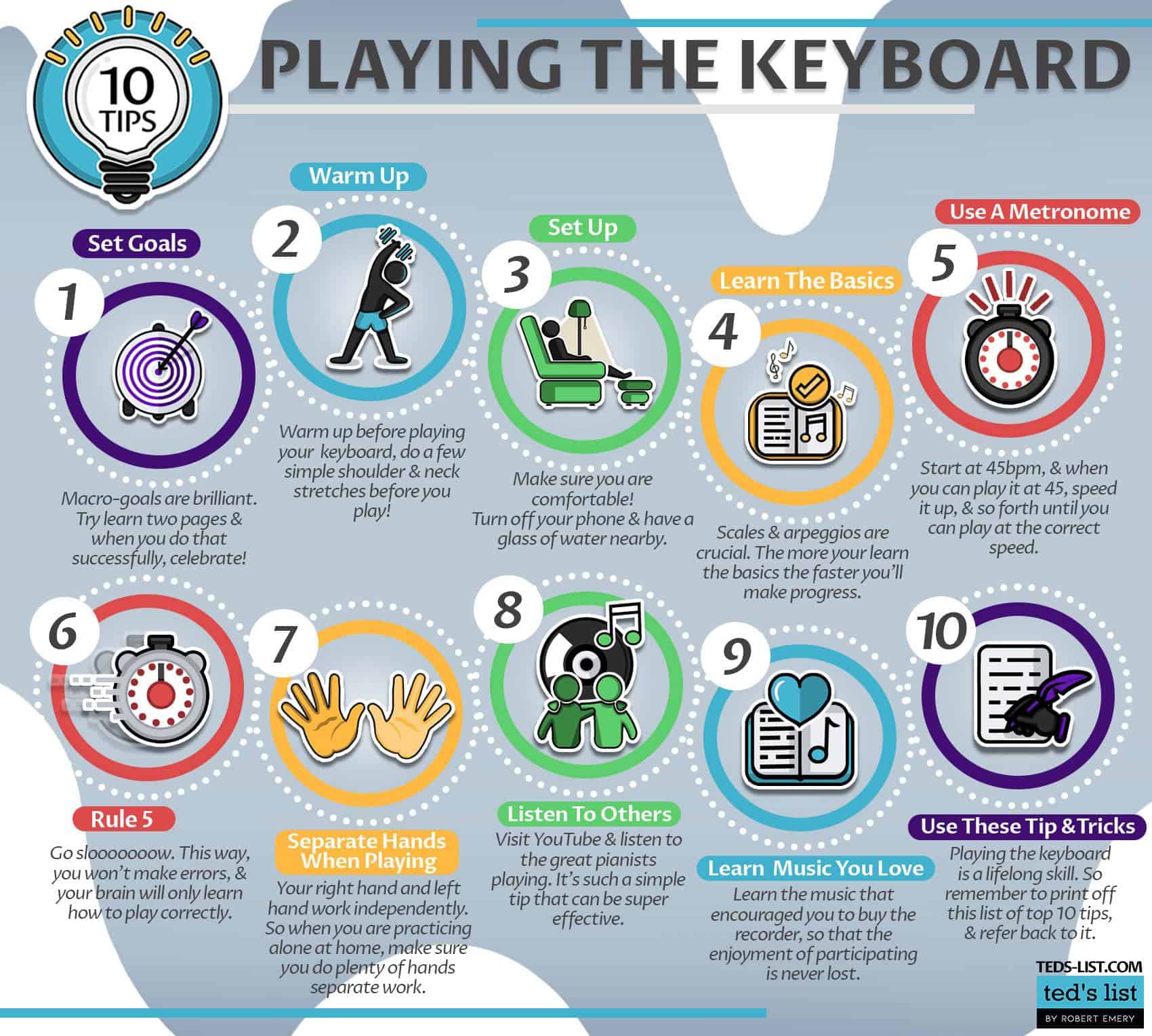If you’re looking for tips and tricks on how to play the keyboard, then this is the place to be! Our top 10 tips to playing the keyboard will help you learn your instrument. They won’t make you an overnight sensation, but they will help you get on the right path to becoming a great pianist or keyboard player.
Set Yourself Goals
ONE
We all need goals in life to move forward. Playing the keyboard isn’t just about sitting down to start playing; it’s about planning what you’re going to learn, and how you’ll get there. Macro-goals are brilliant. Don’t say “I’m going to learn the Rachmaninoff Piano Concerto no 2 in the next six days”, as quite frankly, that’s ludicrous! Instead, say you’ll learn two pages of the concerto. And when you do that successfully, celebrate.
This of course applies just as easily to learning Twinkle, Twinkle, Little Star, as it does to the Rachmaninoff.
Set goals, set your time to practice, and go and do it!
Remember to warm up
TWO
Are warm-ups really necessary? Well, to play the keyboard, you need to work hard, practice, and most importantly, have a great technique. And all of that can come with the toll of backache, arm pain, wrist tension, to name just a few things. So if you’d like to avoid those not-so-fun symptoms of keyboard playing, I’d advise a nice warm-up; just to get you started…
Get your surroundings sorted
THREE
You’ll probably see your piano teacher once a week, at best. The majority of the time you’re practicing the keyboard by yourself, so make sure you are comfortable! Turn off your phone, have a glass of water nearby, and carve out time in your schedule to have some dedicated practicing. It doesn’t matter if it’s 15 minutes or three hours, it’s the quality of the piano practice that matters.
Learn the basics
FOUR
I know scales and arpeggios are not fun, but they are crucial. Just read about them here in our ‘Beginners Guide to Playing the keyboard‘ – and you’ll find out why. Learning the keyboard or piano is difficult, but the quicker you understand that pretty much all music is either scale or arpeggio based, the faster you’ll make progress. So love them or hate them, the basics are here to stay!
Don't be scared to use a Metronome
FIVE
If you can’t play a piece of music in time, then you still have some work to do.
“Flight of the Bumblebee” is played, depending on how you count it, at about 450bpm for instance. But don’t start trying to learn the piece at 450bpm. It’ll never happen! Start at 45bpm, and when you can play it at 45, speed it up to 55, and so forth until you can play at the correct speed. Your muscle memory needs to learn the piece, your keyboard skills will increase as you practice at a slow tempo, you can remember important (but boring) things like having a proper posture, making sure you have regular breaks, and check your hand position – particularly keep an eye on that index finger!
A metronome is sooooo useful. Make sure you listen to the beat, follow it, and never stop using it. It doesn’t matter if you’re a complete beginner, or a professional, we all use metronomes.
Just to check you understood, see rule five
SIX
We can’t stress this piano practice tip enough. Good musicians learn how to practice a fast piece at a tenth of its speed, and then gradually speed it back up to a normal pace. And what is the reason for this? Your brain!
When you play things too fast, you’ll make mistakes. Every time you play the keyboard, your brain is learning what you play. It learns the correct notes you play, but it also learns the mistakes. So if you are playing too fast, and making lots of errors, your brain will be learning those errors.
The alternative, which is our suggestion, is to go slooooooow. This way, you won’t make errors, and your brain will only learn how to play the piece correctly. When you gradually build up the speed, your brain also builds up the neurons of how to play the piece. And eventually, learning to play like this will mean minimal mistakes and your best performance. When you see on the sheet music is what you will play on the keyboard!
Don't always play hands together
SEVEN
Your right hand and left hand work independently – so why do you always practice them at the same time? Sure, when you are playing to your teacher in the piano lesson you’ll use both hands, as it’s like a mini-performance. But when you are practicing alone at home, make sure you do plenty of hands separate work. And try different things.
Close your eyes and see if you can play your right-hand part alone without mistakes. Then when you try your left hand alone, play games like missing out the notes that your thumb plays. All of these things are difficult, they make you concentrate harder, and as a consequence, you’ll learn faster.
Listen to other keyboard players
EIGHT
Name your top 10 favourite pianists. You have to know what “great” sounds like to sound great yourself, so if you don’t have the list, go to YOuTube and listen to more pianists. It’s such a simple tip that can be super effective.
Learn the music you love
NINE
Playing the keyboard isn’t always about the exercises and exam pieces that you need for your piano lessons. It should also be about fun and enjoyment. So make sure you are always playing a piece of music, or song, that you enjoy and is popular. Never forget you are learning to play the keyboard as an enjoyable way to spend your time!
Remember these tips and tricks!
TEN
It may sound obvious, but this list of tips and tricks will be helpful forevermore. Playing piano is a lifelong skill that you can acquire. And learning the keyboard is not just about piano practice, piano lessons, reading the sheet music correctly, remembering all the chords and keys, playing in tempo, playing the correct rhythm and using the correct fingers (I could literally go on all day with this list).
It’s about enjoying yourself. And like most things in life, if you see rapid progress, you’ll enjoy things more. And if you enjoy things more, you’ll make more progress. It’s the circle of life! So remember to print off this list of top 10 tips, and refer back to it regularly.
Learn Keyboard - Top 10 Tips
Summary
Do you want to share this infographic on your site? Use this code...
FAQ's
The easiest way to learn the play the keyboard or play the piano, is to practice. Piano practice is the key – there is no shortcut! The most effective way to learn piano is to try to play every day. Choose a method of learning to play – with the most effective option private, one to one lessons. This is the best way to learn.
Learning piano is tricky, and the fastest way to learn piano is by having private piano lessons. But lessons alone won’t make you learn fast. All students need to practice their instrument regularly. Your piano practice is the thing that’ll make you musical. And it doesn’t matter if you’re on a cheap keyboard or an expensive grand piano, the practice part of your learning process is the element that will make you. As for the easiest way to learn the piano – there isn’t one! Learning any instrument is difficult, and all teachers will say the same thing. Practice makes perfect – especially with playing piano!
You can teach yourself to play the piano by watching online tutorials. These ‘free piano lessons’ will only get you so far though. If you really want to progress, you need a great teacher. You can improve your piano skills by working on separate elements. Make sure your hand position and technique is correct. Make sure you are able to play your piece at a slow tempo first before speeding up. Work on your ‘ear training’. Make sure you know what chord is what. Work on your sight-reading. And above all else, have consistency in your practice. Then one day, you’ll be the pianist you want to be!












Regarding the tip on ‘Don’t always play hands together,’ it’s crucial to mention the benefits of hand independence for novice players. Developing the ability to play different rhythms and melodies independently in each hand can significantly improve a player’s versatility and skill. It’s a foundational skill that every keyboard player should work on.
I found the advice on ‘Get your surroundings sorted’ quite useful. Making a dedicated space for practice seems obvious, but I hadn’t really considered how it might affect my learning progress.
really loved the part about not being scared to use a metronome. ive always had a bit of a struggle keeping in time when im jamming out on my own, and using a metronome has seriously upped my game. anyone else found some cool tricks to keep in time?
where can you find good drum tracks? struggle with this myself.
Absolutely, using a metronome is a game-changer! I also practice with drum tracks I find online. It adds a fun layer to the practice.